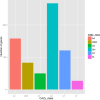Whole genome sequencing and analysis of Armillaria gallica Jzi34 symbiotic with Gastrodia elata
- PMID: 37217849
- PMCID: PMC10204328
- DOI: 10.1186/s12864-023-09384-4
Whole genome sequencing and analysis of Armillaria gallica Jzi34 symbiotic with Gastrodia elata
Abstract
Background: Armillaria species are plant pathogens, but a few Armillaria species can establish a symbiotic relationship with Gastrodia elata, a rootless and leafless orchid, that is used as a Chinese herbal medicine. Armillaria is a nutrient source for the growth of G. elata. However, there are few reports on the molecular mechanism of symbiosis between Armillaria species and G. elata. The genome sequencing and analysis of Armillaria symbiotic with G. elata would provide genomic information for further studying the molecular mechanism of symbiosis.
Results: The de novo genome assembly was performed with the PacBio Sequel platform and Illumina NovaSeq PE150 for the A. gallica Jzi34 strain, which was symbiotic with G. elata. Its genome assembly contained ~ 79.9 Mbp and consisted of 60 contigs with an N50 of 2,535,910 bp. There were only 4.1% repetitive sequences in the genome assembly. Functional annotation analysis revealed a total of 16,280 protein coding genes. Compared with the other five genomes of Armillaria, the carbohydrate enzyme gene family of the genome was significantly contracted, while it had the largest set of glycosyl transferase (GT) genes. It also had an expansion of auxiliary activity enzymes AA3-2 gene subfamily and cytochrome P450 genes. The synteny analysis result of P450 genes reveals that the evolutionary relationship of P450 proteins between A. gallica Jzi34 and other four Armillaria was complex.
Conclusions: These characteristics may be beneficial for establishing a symbiotic relationship with G. elata. These results explore the characteristics of A. gallica Jzi34 from a genomic perspective and provide an important genomic resource for further detailed study of Armillaria. This will help to further study the symbiotic mechanism between A. gallica and G. elata.
Keywords: Armillaria; Gastrodia elata; Genome; Molecular mechanism; Symbionts.
© 2023. The Author(s).
Conflict of interest statement
The authors declare no competing interests.
Figures







Similar articles
-
The role of symbiotic fungi in the life cycle of Gastrodia elata Blume (Orchidaceae): a comprehensive review.Front Plant Sci. 2024 Jan 8;14:1309038. doi: 10.3389/fpls.2023.1309038. eCollection 2023. Front Plant Sci. 2024. PMID: 38264031 Free PMC article. Review.
-
Characteristics and functions of volatile organic compounds in the tripartite symbiotic system of Gastrodia elata-Armillaria gallica-Rahnella aceris HPDA25.Plant Signal Behav. 2024 Dec 31;19(1):2399426. doi: 10.1080/15592324.2024.2399426. Epub 2024 Sep 4. Plant Signal Behav. 2024. PMID: 39231270 Free PMC article.
-
Draft genomic sequence of Armillaria gallica 012m: insights into its symbiotic relationship with Gastrodia elata.Braz J Microbiol. 2020 Dec;51(4):1539-1552. doi: 10.1007/s42770-020-00317-x. Epub 2020 Jun 22. Braz J Microbiol. 2020. PMID: 32572836 Free PMC article.
-
Whole genome sequencing and analysis of the symbiotic Armillaria gallica M3 with Gastrodia elata.BMC Genomics. 2025 Mar 31;26(1):324. doi: 10.1186/s12864-024-10897-9. BMC Genomics. 2025. PMID: 40165074 Free PMC article.
-
Research Status and Application Prospects of the Medicinal Mushroom Armillaria mellea.Appl Biochem Biotechnol. 2023 May;195(5):3491-3507. doi: 10.1007/s12010-022-04240-9. Epub 2022 Nov 22. Appl Biochem Biotechnol. 2023. PMID: 36417110 Review.
Cited by
-
The role of symbiotic fungi in the life cycle of Gastrodia elata Blume (Orchidaceae): a comprehensive review.Front Plant Sci. 2024 Jan 8;14:1309038. doi: 10.3389/fpls.2023.1309038. eCollection 2023. Front Plant Sci. 2024. PMID: 38264031 Free PMC article. Review.
-
Hallmarks of Comparative Transcriptome between Rhizomorphs and Hyphae of Armillaria sp. 541 Participating in Fungal Symbiosis with Emphasis on LysM Domains.Microorganisms. 2023 Jul 27;11(8):1914. doi: 10.3390/microorganisms11081914. Microorganisms. 2023. PMID: 37630474 Free PMC article.
-
Characteristics and functions of volatile organic compounds in the tripartite symbiotic system of Gastrodia elata-Armillaria gallica-Rahnella aceris HPDA25.Plant Signal Behav. 2024 Dec 31;19(1):2399426. doi: 10.1080/15592324.2024.2399426. Epub 2024 Sep 4. Plant Signal Behav. 2024. PMID: 39231270 Free PMC article.
-
Variation in SSRs at different genomic regions and implications for the evolution and identification of Armillaria gallica.PLoS One. 2024 Oct 15;19(10):e0312114. doi: 10.1371/journal.pone.0312114. eCollection 2024. PLoS One. 2024. PMID: 39405284 Free PMC article.
References
-
- Yang CS, Chiu SC, Liu PY, Wu SN, Lai MC, Huang CW. Gastrodin alleviates seizure severity and neuronal excitotoxicities in the rat lithium-pilocarpine model of temporal lobe epilepsy via enhancing GABAergic transmission. J Ethnopharmacol. 2021;269:113751. doi: 10.1016/j.jep.2020.113751. - DOI - PubMed
MeSH terms
Supplementary concepts
Grants and funding
LinkOut - more resources
Full Text Sources
Miscellaneous

